Sp: Hace aproximadamente 6 meses, la FEDP (FEDERACIÓN ESPAÑOLA DE PIRAGÜISMO), contactó conmigo con un objetivo:
España, tradicionalmente ha sido un equipo muy bueno en K4; pero el equipo Alemán, siempre, ha estado muy parecido a España, en los campeonatos del mundo; la RFEP quería “algo más”; no sólo ganar a Alemania, sino disponer de una línea o método de trabajo para optimizar la piragua K4 y por tanto, sus resultados. El objetivo era el año 2023….
En: About 6 months ago, the FEDP (FEDERACIÓN ESPAÑOLA DE PIRAGÜISMO), contacted me with an objective:
Spain, traditionally has been a very good team in K4; but the German team, always, has been very similar to Spain in the world championships; the RFEP wanted “something more”; not only to beat Germany, but to have a line or method of work to optimize the K4 canoe and therefore, its results. The objective was the year 2023….

Sp: Para realizar esta tarea, la Ingeniería existente en la actualidad, tiene diversos métodos; uno de ellos, es el uso del CANAL DE AGUA; España, tiene uno de los canales más grandes del mundo, en Canal de ENSAYOS HIDRODINÁMICOS de EL PARDO, en Madrid; los problemas principales que tiene el uso de estos canales, son 2:
- La piragua ha de estar YA CONSTRUIDA.
- El alto precio por hora de uso del canal.
Ambas razones son muy importantes para limitar el uso de la herramienta de ensayo.
En: To carry out this task, the existing Engineering at the present time, has diverse methods; one of them, is the use of the WATER CANAL; Spain, has one of the biggest canals of the world, in Canal de ENSAYOS HIDRODINÁMICOS de EL PARDO, in Madrid; the main problems that has the use of these canals, are 2:
– The canoe has to be ALREADY CONSTRUCTED.
– The high price per hour of use of the canal.
Both reasons are very important to limit the use of the test tool.

Sp: Esta fue una de las razones fundamentales para que los responsables de la RFEP contactasen conmigo: soy especialista en CFD; la herramienta CFD, es una herramienta informática que resuelve los 2 problemas anteriores, pudiendo además, ensayar muchos modelos para elegir el mejor; el objetivo principal por tanto, era:
- Ensayar muchas variaciones de la piragua del año anterior, con la idea de mejorarla.
El CFD, es la mejor herramienta para conseguir este objetivo….
En: This was one of the main reasons for the RFEP to contact me: I am a specialist in CFD; the CFD tool is a computer tool that solves the 2 previous problems, and I can also test many models to choose the best one; the main objective was therefore:
– To test many variations of the previous year’s canoe, with the idea of improving it.
The CFD is the best tool to achieve this goal….

Sp: El primer problema con el que nos encontramos, fue que la piragua, no estaba en formato CAD, apto para el software CFD; para ello, se trabajó del siguiente modo:
- 2 de las zonas más importantes en una piragua debida a su necesidad de exactitud, es la zona frontal y la zona trasera; por ello, se eligió el escaneo de ambas zonas; ello permite tener mucha precisión en las superficies creadas:
En: The first problem we encountered was that the canoe was not in CAD format, suitable for CFD software; for this reason, we worked as follows:
– 2 of the most important areas in a canoe, due to its need for accuracy, are the front and rear areas; for this reason, we chose to scan both areas; this allows us to be very precise in the surfaces created:

Sp: A estas zonas ya dibujadas en formato CAD, se le fue añadiendo “trozos” de superficie del casco (hull) formado por secciones; estas secciones eran más sencillas de “medir”…:
En: – To these areas already drawn in CAD format, “pieces” of hull surface (hull) formed by sections were added; these sections were easier to “measure”….:

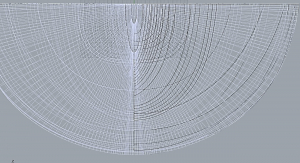
Sp: Este fue un paso muy importante, ya que es absolutamente necesario tener un CAD para poder realizar un análisis CFD.
Otro problema que se creó, es la necesidad de que este CAD fuese apto para el software CFD; esto es: el CAD a ensayar mediante CFD, debe tener unas características adecuadas para cada software CFD; una de las características o propiedades que debe cumplir, es que debe ser una superficie cerrada; esto es: no tener agujeros o discontinuidades entre las diferentes superficies o trozos; además, las uniones entre superficies, deben cumplir algunas propiedades pero principalmente es que las zonas de contacto, deben tener la misma tangencia. Esto es muy importante y necesario.
Conseguir esto, no es fácil pero se consiguió; era necesario conseguirlo para poder continuar con el análisis….
El siguiente paso era mallar con una buena malla, toda la superficie de la piragua, así como la del canal de agua; respecto el canal y sus dimensiones, se eligieron unas medidas que permitían que los datos que se iban a calcular, fuesen lo más reales posibles; si el canal es muy pequeño, la influencia de las paredes del canal sobre la piragua es muy evidente, y los resultados NO SON LOS REALES COMO SI LA PIRAGUA ESTUVIERA EN UN CANAL ABIERTO, EL MAR, ETC….
Este efecto, se denomina “EFECTO PARED”.
En: This was a very important step, as it is absolutely necessary to have a CAD in order to be able to carry out a CFD analysis.
Another problem that was created is the need for this CAD to be suitable for the CFD software; that is: the CAD to be tested by means of CFD must have the appropriate characteristics for each CFD software; one of the characteristics or properties that it must fulfil is that it must be a closed surface; that is: it must not have holes or discontinuities between the different surfaces or pieces; also, the joints between surfaces must fulfil some properties, but mainly the contact areas must have the same tangency. This is very important and necessary.
Achieving this is not easy but it was achieved; it was necessary to achieve it to be able to continue with the analysis…..
The next step was to mesh with a good mesh, the whole surface of the canoe, as well as the water channel; regarding the channel and its dimensions, some measures were chosen that allowed the data to be calculated, to be as real as possible; if the channel is very small, the influence of the walls of the channel on the canoe is very evident, and the results ARE NOT THE REAL AS IF THE CANOE WERE IN AN OPEN CHANNEL, THE SEA, ETC…..
This effect is called “WALL EFFECT”.

Sp: El hecho de generar una malla a todo el CAD, es sustituir el CAD por otro CAD formado por la malla; cualquier software de CFD trabaja con la malla creada, no con el CAD original; esto es: la malla, es el nuevo CAD para el software CFD; por eso, la malla, ha de cumplir varias cosas:
- Ha de ser lo más parecida posible al CAD original….
- Ha de ser lo más pequeña posible para reproducir perfectamente (realmente) no sólo el CAD original, también los efectos de las olas creadas.
Para conseguir estos 2 objetivos, es necesario analizar en profundidad:
- Reproducir la capa límite sobre la piragua; esto es absolutamente esencial y la exactitud en los resultados depende de ello; hay que analizar de una manera profunda y saber, que la capa límite es muy diferente al caso del aire; el espesor y la distribución de capas, son muy diferentes en ambos casos.
- Reproducir el modelo de turbulencia; se está trabajando con agua, aire y a baja velocidad….
- Reproducir las olas, en el caso de ensayar la piragua con olas.
- Reproducir la rugosidad de la superficie de la piragua; se tiende a pensar de que es nula, pero no lo es….
Una vez se tiene todo esto, ya estamos en condiciones para realizar la primer simulación CFD; la primera simulación CFD, es la más importante, pues indica los tamaños de malla mejores para alcanzar una buena precisión y exactitud.
En: The fact of generating a mesh to the whole CAD, is to replace the CAD by another CAD formed by the mesh; any CFD software works with the mesh created, not with the original CAD; that is: the mesh is the new CAD for the CFD software; therefore, the mesh has to fulfil several things:
– It has to be as similar as possible to the original CAD ….
– It has to be as small as possible to reproduce perfectly (really) not only the original CAD, but also the effects of the waves created.
To achieve these 2 objectives, it is necessary to analyse in depth:
– To reproduce the boundary layer on the canoe; this is absolutely essential and the accuracy of the results depends on it; you have to analyse in a deep way and know, that the boundary layer is very different from the air case; the thickness and the distribution of layers, are very different in both cases.
– Reproduce the turbulence model; you are working with water, air and at low speed ….
– Reproduce the waves, in the case of testing the canoe with waves.
– Reproduce the roughness of the surface of the canoe; one tends to think that it is null, but it is not…..
Once we have all this, we are ready to perform the first CFD simulation; the first CFD simulation is the most important, as it indicates the best mesh sizes to achieve good precision and accuracy.

Sp: Si estuviéramos analizando un Fórmula 1 en particular, una buena malla contiene aproximadamente no menos de 30 millones de nodos; en este caso de la piragua, contiene aproximadamente unos 15 millones; son muchos nodos, pero suficientes para tener una muy buena exactitud en los resultados; el tiempo de cálculo aproximado para cada simulación es de unas 5 horas (512 Gb Ram y 100 núcleos; dispongo de un PC con esta características).
Aproximadamente se pueden realizar 2-3 simulaciones diarias. Ello es suficiente para hacer un estudio completo de creación y optimización en 1 mes.
2 asuntos Importantes:
—-Los ensayos a realizar, son de 2 tipos:
- Sin olas.
- Con olas; es necesario determinar las alturas y longitudes de las olas creadas, y también su frecuencia.
—-Qué parámetros o datos es necesario calcular para poder decir que un modelo de piragua u otro, es mejor ¿???
Es una muy buena pregunta; fue algo complicado de decidir, pero se eligieron los siguientes argumentos:
- Sustentación (Lift o Downforce) creada.
- Drag o resistencia creada.
- Oscilaciones en pitch (arriba / abajo); una generación “excesiva” produce drag….
- Línea de flotación.
- Cantidad de agua (kilos principalmente) desplazada por la piragua; es consecuencia directa de la línea de flotación.
- Olas creadas; una generación “excesiva”, produce drag….: se calculan las alturas y longitudes de las olas.
En: If we were analysing a Formula 1 in particular, a good mesh contains approximately no less than 30 million nodes; in this case of the canoe, it contains approximately 15 million; this is a lot of nodes, but enough to have a very good accuracy in the results; the approximate calculation time for each simulation is about 5 hours (512 Gb Ram and 100 cores; I have a PC with these characteristics).


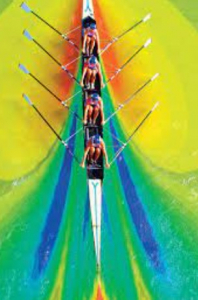
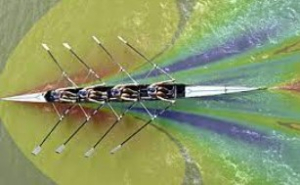
Sp: Otra pregunta o consideración esencial:
Todos los diseños a ensayar, dependen de varios factores:
- Forma geométrica del casco (principalmente de la parte sumergida….).
- Reparto de pesos inicial; el reparto de pesos, algo muy importante, se realiza mediante la posición de los 4 deportistas en la piragua; NO TODOS los deportistas pesan exactamente lo mismo…. De esta forma, se puede variar el centro de gravedad de la piragua. La posición del centro de gravedad de la piragua, es uno de los parámetros esenciales a introducir en cada simulación y en cada comparación. Junto a la geometría, son los 2 parámetros de comparación principales.
- Densidad, Viscosidad, Temperatura y Presión Atmosférica (aire, pero principalmente del agua). Para ello, se eligieron unos valores “estándar” para los 2 fluidos.
- También es importante realizar simulaciones a varias velocidades, aunque existe una velocidad estándar, que sirve de referencia; suele estar alrededor de 6 m/s.
En: Another essential question or consideration:
All designs to be tested, depend on several factors:
– Geometric shape of the hull (mainly of the submerged part ….).
– Initial weight distribution; the weight distribution, which is very important, is done by the position of the 4 athletes in the canoe; NOT ALL athletes weigh exactly the same….. In this way, the centre of gravity of the canoe can be varied. The position of the centre of gravity of the canoe is one of the essential parameters to introduce in every simulation and in every comparison. Together with the geometry, they are the 2 main comparison parameters.
– Density, Viscosity, Temperature and Atmospheric Pressure (air, but mainly water). For this purpose, “standard” values were chosen for the 2 fluids.
– It is also important to perform simulations at various velocities, although there is a standard velocity, which serves as a reference; it is usually around 6 m/s.
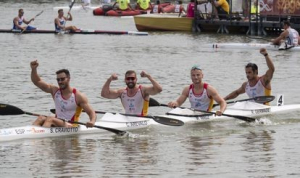
Sp: Otra característica que ha de hacerse en cada simulación, es la llamada estabilización del flujo; esto es: cuando se empieza a hacer la simulación, sea con olas o sin olas, la piragua tiende a alcanzar una profundidad o línea de flotación determinada; cuando llega a esta posición (después de varias oscilaciones), es el momento para empezar a almacenar datos y resultados. Es necesario que la simulación llegue a esta estabilización para poder seguir; normalmente, se llega en unos 5 segundos de tiempo real.
Otra consideración muy importante:
Evidentemente, la razón por la cual se mide la Drag, es exactamente la misma por la cual, en Motorsport, también se mide; ha de ser mínima ya que si es mínima la velocidad hacia adelante es máxima; es algo obvio y necesario; pero:
Cuál es la razón para calcular el lift o downforce ????
La razón también es obvia:
Cuanta más “LIFT” tenga la piragua, la LÍNEA DE FLOTACIÓN, estará situada más hacia abajo; por tanto, la zona sumergida será menor; ello hace que la resistencia por fricción entre la piragua y el agua (una de las razones fundamentales y principales de la drag total) sea mínima.
Existen 2 fluidos en este tipo de simulación CFD:
- Aire.
- Agua.
Pero el fluido “más importante” a analizar y las consecuencia de su dinámica, es el agua…. Recordar que el agua tiene 1000 veces más densidad que el aire y mucha más viscosidad…. Esta es la razón fundamental por la cual se realiza un análisis CFD hidrodinámico y no aerodinámico….
Por tanto, la posición de la línea de flotación y sus variaciones debido a las variaciones de pitch (arriba / abajo) es prácticamente lo más relevante, junto a la drag.
Resumen: Los 2 valores con mayor importancia de cálculo:
- Drag.
- Posición de la línea de flotación (CUANDO LA SIMULACIÓN YA ESTÉ ESTABILIZADA).
La línea de flotación, en CFD, es bastante sencillo de calcular; la mayoría de códigos CFD, no todos, disponen de un valor llamado “VOLUME FRACTION”, que indica la proporción de fluido en código de colores en contacto con una superficie: entre rojo (“1” o “100%” y azul “0” o “0%”); en la siguiente imagen a modo de ejemplo (no con la piragua K4), el color rojo corresponde al aire con valor “1” o “100% (la zona “azul” es la sumergida):
En: Another feature that has to be done in every simulation is the so-called stabilisation of the flow; that is: when the simulation is started, either with or without waves, the canoe tends to reach a certain depth or waterline; when it reaches this position (after several oscillations), it is the moment to start storing data and results. It is necessary for the simulation to reach this stabilisation in order to continue; normally, this is reached in about 5 seconds of real time.
Another very important consideration:
Obviously, the reason why Drag is measured, is exactly the same reason why, in Motorsport, it is also measured; it has to be minimum because if it is minimum the forward speed is maximum; it is something obvious and necessary; but:
What is the reason for calculating lift or downforce ????
The reason is also obvious:
The more “LIFT” the canoe has, the FLOATATION LINE, the more downward the canoe will be located; therefore, the submerged area will be smaller; this makes the frictional resistance between the canoe and the water (one of the fundamental and main reasons for the total drag) to be minimal.
There are 2 fluids in this type of CFD simulation:
– Air.
– Water.
But the “most important” fluid to analyse and the consequences of its dynamics is water….. Remember that water has 1000 times more density than air and much more viscosity…. This is the fundamental reason why a hydrodynamic and not an aerodynamic CFD analysis is carried out…..
Therefore, the position of the waterline and its variations due to pitch variations (up/down) is practically the most relevant, next to the drag.
Summary: The 2 most important values for calculation:
– Drag.
– Waterline position (WHEN THE SIMULATION IS ALREADY STABILISED).
The waterline, in CFD, is quite simple to calculate; most CFD codes, not all, have a value called “VOLUME FRACTION”, which indicates the proportion of fluid in colour code in contact with a surface: between red (“1” or “100%” and blue “0” or “0%”); in the following image as an example (not with the K4 canoe), the red colour corresponds to air with value “1” or “100%” (the “blue” area is the submerged area):
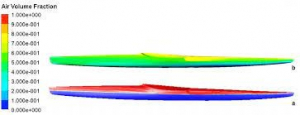
Sp: A continuación, se exponen algunas imágenes reales del estudio realizado para el equipo español (se obvian, lógicamente, valores numéricos….) por razones de confidencialidad:
En: Below are some real images from the study carried out for the Spanish team (numerical values are of course omitted….) for reasons of confidentiality:
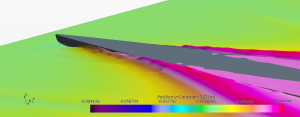
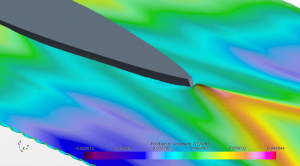
![]()


![]()
Sp: Estoy muy orgulloso de haber trabajado con el equipo español y espero se repita sin ninguna duda. NO sólo es un orgullo y una enorme responsabilidad; además me ha permitido crecer como Ingeniero de CFD, ya que era un mundo, el del piragüismo, que nunca lo había trabajado, al menos, desde un punto de vista profesional. Apasionante reto de ingeniería.
El proyecto que se presenta en este Artículo, fue un proyecto apasionante; un reto tecnológico muy importante. BUSCO REPETIRLO PARA OTROS EQUIPOS DE PIRAGÜISMO ALREDEDOR DEL MUNDO; contactad con: racecarsengineering@gmail.com , para preguntar sobre la contratación de estos Servicios CFD. Estoy abierto a cualquier idea, sugerencia o propuesta.
En: I am very proud to have worked with the Spanish team and I hope it will be repeated without any doubt. It is not only a source of pride and an enormous responsibility; it has also allowed me to grow as a CFD engineer, as it was a world, that of canoeing, that I had never worked in, at least from a professional point of view. An exciting engineering challenge.
The project presented in this article was an exciting project; a very important technological challenge. I AM LOOKING FOR A REPEAT FOR OTHER CRAFTING TEAMS AROUND THE WORLD; please contact: racecarsengineering@gmail.com , to enquire about contracting these CFD Services. I am open to any ideas, suggestions or proposals.

Sp: Desde GRAINING, se ha hecho especial énfasis en la utilización de esta poderosa herramienta que es el CFD.
En: GRAINING has placed special emphasis on the use of this powerful CFD tool.

Sp: De hecho, se ha dado mucha importancia a una escuela de CFD, creada en Graining y a través de Graining:
https://www.graining.es/cfd-academy-para-universidades-espanolas/
Al respecto, existe un Curso ONLINE de CFD: https://www.graining.es/wp-content/uploads/2023/04/FORMATION-ONLINE-IN-CFD.pdf
En: In fact, much importance has been given to a CFD school, created in Graining and through Graining:
https://www.graining.es/cfd-academy-para-universidades-espanolas/
In this respect, there is an ONLINE CFD Course: https://www.graining.es/wp-content/uploads/2023/04/FORMATION-ONLINE-IN-CFD.pdf
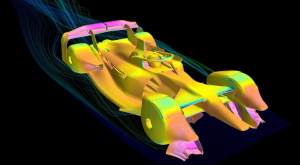
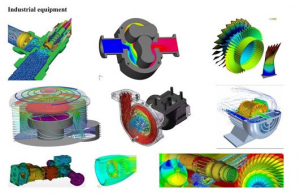
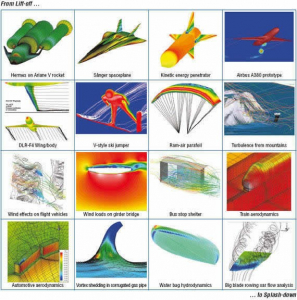
Sp: Autor: TIMOTEO BRIET BLANES.
Matemático, Ingeniero Aerodinámico y CFD; profesor de Aero y CFD en varios Másters de Motorsport: Ismans (Le Mans), SUN RED (Barcelona), UPV Valencia; colaborador en el Máster METCA (Epsilon Euskadi) y otros; diseñador de PIKES PEAK (lamourlepinacle.com), XERUS (Bus de Tata Motors), Aprilia, etc….
En: Author: TIMOTEO BRIET BLANES.
Mathematician, Aerodynamic and CFD Engineer; professor of Aero and CFD in several Motorsport Masters: Ismans (Le Mans), SUN RED (Barcelona), UPV Valencia; collaborator in the METCA Master (Epsilon Euskadi) and others; designer of PIKES PEAK (lamourlepinacle.com), XERUS (Bus of Tata Motors), Aprilia, etc…..
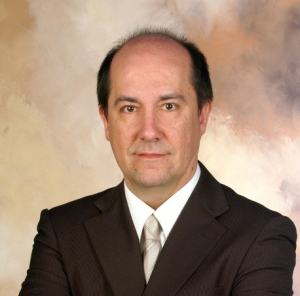

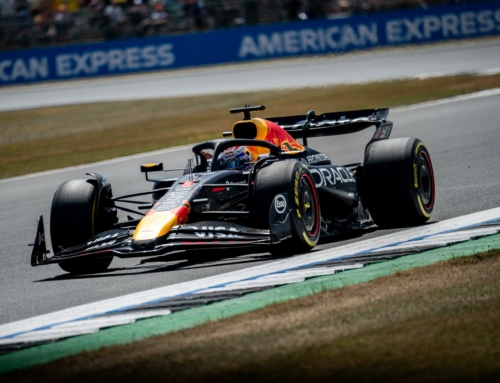
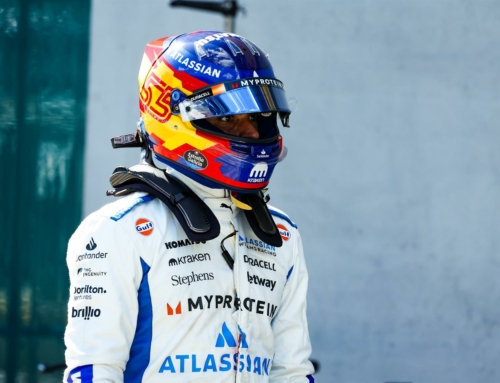

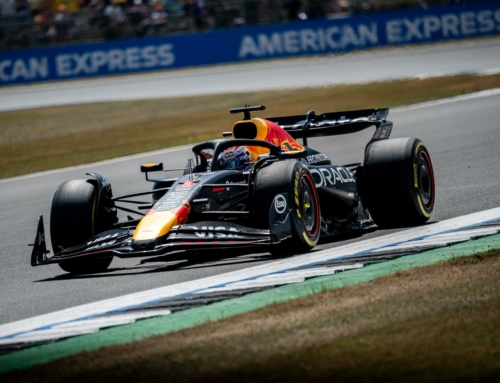
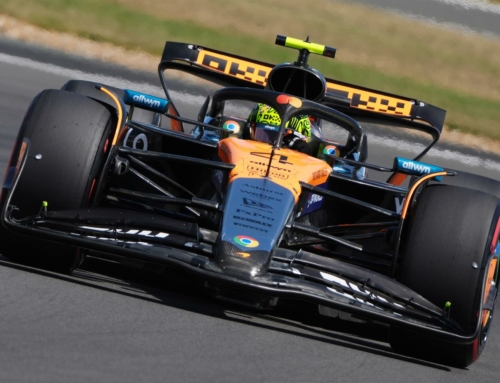
Leave A Comment